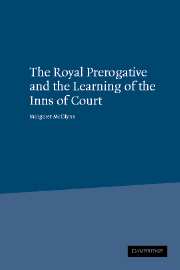Book contents
- Frontmatter
- Contents
- Preface
- List of figures
- List of abbreviations
- Introduction
- 1 The early readings
- 2 Expansion and debate
- 3 Frowyk and Constable on primer seisin
- 4 Spelman, Yorke, and the campaign against uses
- 5 The Edwardian readers and beyond
- Conclusion
- Notes on the appendixes
- Appendix 1 Thomas Frowyk's reading on Prerogativa Regis
- Appendix 2 John Spelman's reading on Prerogativa Regis
- Bibliography
- Index
3 - Frowyk and Constable on primer seisin
Published online by Cambridge University Press: 04 July 2009
- Frontmatter
- Contents
- Preface
- List of figures
- List of abbreviations
- Introduction
- 1 The early readings
- 2 Expansion and debate
- 3 Frowyk and Constable on primer seisin
- 4 Spelman, Yorke, and the campaign against uses
- 5 The Edwardian readers and beyond
- Conclusion
- Notes on the appendixes
- Appendix 1 Thomas Frowyk's reading on Prerogativa Regis
- Appendix 2 John Spelman's reading on Prerogativa Regis
- Bibliography
- Index
Summary
By the late fifteenth century there was no doubt that the heir of full age would receive his ancestor's lands as a matter of course, but primer seisin remained unpopular with tenants. The immediate loss of income was one concern, both in the loss of issues while the king held the land and in the sum the heir had to pay for livery. Primer seisin also gave the king the opportunity to investigate the titles by which his tenants held their lands, and its reach was wider than wardship, for every parcel of land was open to primer seisin, while wardship could be avoided, either through natural good fortune or evasion. Effective implementation of the king's rights to primer seisin meant that over the course of a generation the king could, in theory, carry out a Domesday-like survey of landholding in England.
Primer seisin was to some extent a more sensitive topic than wardship, but the readers approached it in much the same way that they investigated wardship. Both opened their discussion with a brief history of the topic, accepting that the statute of Marlborough ordained that the king should have primer seisin of land held of him in chief, and that this was a confirmation of the common law. Constable points out that “it is reasonable that the king will grant livery of the land which was held of him to the one who will be his tenant of record and will have the issues in the meantime.
- Type
- Chapter
- Information
- The Royal Prerogative and the Learning of the Inns of Court , pp. 112 - 159Publisher: Cambridge University PressPrint publication year: 2003



